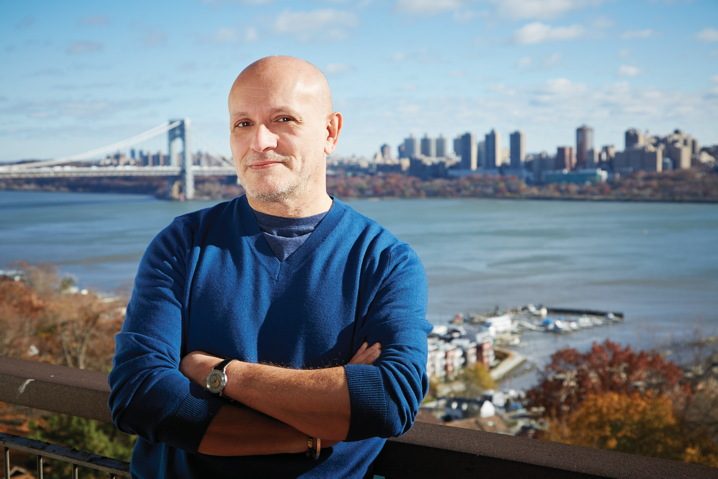
Fabio Parasecoli, 52, an internationally recognized authority on the intersection of food and culture, commutes from his high-rise apartment in Fort Lee to Greenwich Village in Manhattan, where he is an associate professor and director of the Food Studies Initiatives program at the New School. Born and raised in Rome, he spent two years studying contemporary Chinese history in Beijing, earned his PhD. in agricultural sciences in Germany, and came to America in 1998 as U.S. correspondent for the authoritative Italian food and wine magazine, Gambero Rosso. Parasecoli was co-editor, with Peter Scholliers, of the six-volume A Cultural History of Food (2012). His other books include Bite Me: Food in Popular Culture (2008), Al Dente: A History of Food in Italy (2014), and this summer’s Knowing Where It Comes From: Labeling Traditional Foods to Compete in a Global Market. We spoke in his apartment overlooking the Hudson River.
New Jersey Monthly: How did your intimate involvement with food begin?
Fabio Parasecoli: My mom was a teacher, but she managed to cook lunch and dinner every day. We had people over often; normally 12, close family, sometimes more. I have two younger sisters. My mom would call us to the kitchen and give us tasks. My mother wouldn’t ask any help from any other males in the family. Later I realized my mom had one foot in the Italy of the ’60s, very traditional, but she was also a modern woman who wanted probably to raise her male child in a different way. When I was 16, I went to London for three weeks to improve my English. That’s where the first big discovery happened: fast food. This was 1980. We didn’t have fast food in Italy. That was completely fascinating to me. Even more interesting, the family I was staying with were eclectic. They would have rice with curry and shrimp one night, another night they would have shepherd’s pie. That trip pushed me to become more interested in what was outside Italy.
NJM: In the late ’80s, you studied and traveled in China. Do you see an affinity between Italian and Chinese cooking?
FP: I see more affinity with Japanese—the freshness of ingredients, the simplicity. Chinese is a very complex cuisine. Chinese cuisine here is almost nothing like it is in China. [Similarly,] Italian cuisine here is different than the food in Italy. You take it as a different cuisine, not as a bad version of authentic Italian cuisine.
NJM: What are the differences?
FP: The flavoring. In Italian-American tradition, sometimes there is a lot of garlic, a lot of oil, much more than we [in Italy] might use. The portions are humongous—and you’re like, Why? There are dishes we don’t have: spaghetti and meatballs, the baked ziti. We do have some baked pastas in the south, but here they’re very different; everything is so rich. Instead of one to three ingredients, it’s got 10. In Italy, those were holiday dishes; here, they’ve become everyday dishes.
NJM: Why did you subtitle Al Dente “A History of Food in Italy” rather than “A History of Italian Food?”
FP: Because the concept of Italian food is relatively new. It came after unification at the end of the 19th century with the effort of creating food as an expression of a nation. The structure of the government was there, but many Italians had no personal experience of something called Italy. Food was very local. Since in the book I cover everything from prehistory on, for me it made more sense to talk about food in Italy.
NJM: Is food in Italy still very local?
FP: The hyperlocal aspect has come back strongly in the late ’80s and ’90s, but there is also food made in big factories and a massive circulation of products now perceived as Italian. Nutella has an origin in a specific place [Alba, in the northwest]. People still think of panettone as from Milan, but now you eat it all over the country. The same thing with pandoro and torrone.
NJM: You’ve said, “Food is incredibly political.” In what ways?
FP: Think about buying at a farmer’s market versus a big chain. That expresses different political and social outlooks. If I have a problem with labor issues, I might not go to a fast-food chain. Whether to have labels on GMOs is very political. In Newark, AeroFarms turned an old factory building into a vertical farm using aeroponics, a growing technique similar to hydroponics. Patents have been issued on hydroponics. Who has access to it? Can it really become a way to provide food in emergencies?
NJM: How else is food political?
FP: Do you want more or less intervention from the government, from the FDA? How do we control E-coli and salmonella? The federal farm bill is the main bill that determines what we eat—not only in terms of agriculture, but in food stamps and other programs. Funding school food and the WIC will also be discussed. Those are partisan political issues.

Wow! So interesting. I love to read about food, so I can’t wait to check out some of Parasecoli’s books. I also love to see that such interesting people live in NJ.